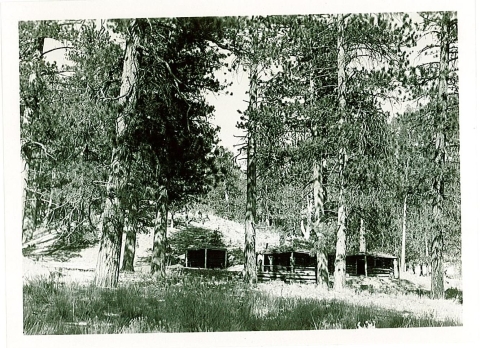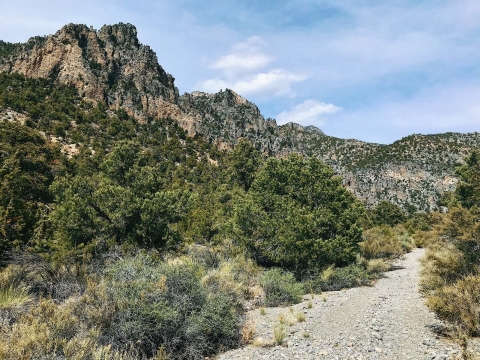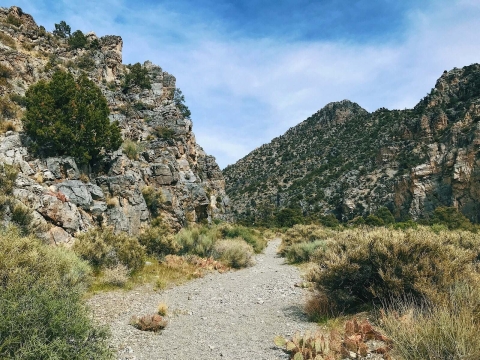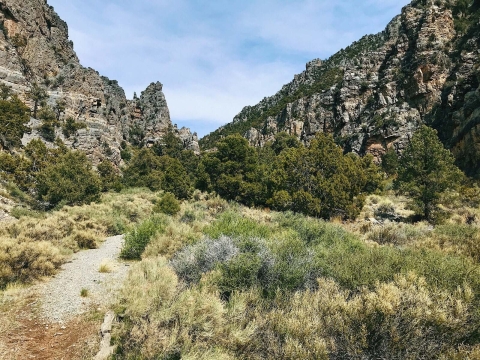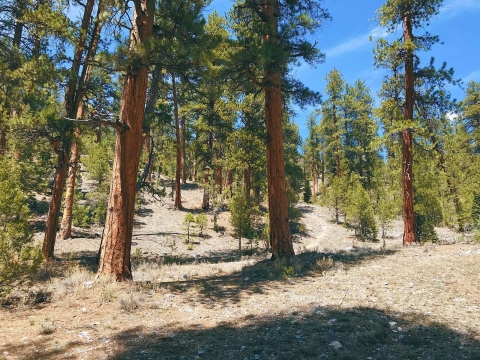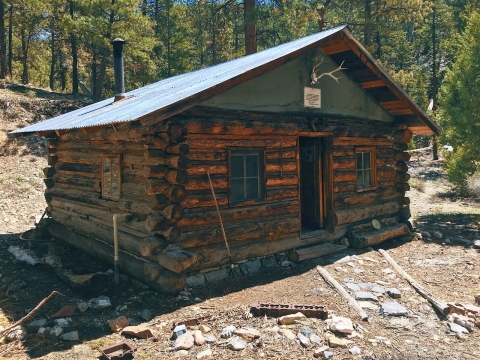The Story
The story of Hidden Forest Cabin begins in 1931 with a man named Clarence Russell. A shell-shocked (now called post-traumatic stress disorder) veteran of WWI, Russell attempted to homestead the forest before the federal government withdrew the area as a wildlife refuge. Russell lived at the site for a year, hoping to develop the site under the Homestead Act.
In June 1932, Russell visited the ranch of C.P. 'Red' Moore at White Rock Springs, seven miles from his own site, and shot Moore to death in a drunken rage when Moore became involved in an argument with him. According to The Evening Review-Journal (now the Las Vegas Review-Journal), Russell then went after Moore's son, Howard, who was able to arm himself and in turn, killed Russell.
After Russell's death, a score of rumors spread through the burgeoning Las Vegas Valley like a prairie fire. He was reported to have been a Chicago gangster hiding out and bootlegging liquor from his cabin. This legend apparently grew from Russell's frequent boasts when 'likkered up' that he was a ‘gangland tough guy’ and his habit of wild shootings on such occasions lent credence to the report. Prospectors who knew Russell insisted he had a fortune in diamonds buried near his cabin.
Almost as quickly as Russell’s notoriety spread it was forgotten. Based on the land records, no one ever filed a homestead patent or mining claim for the property, and there is no person or name associated with the cabin. As far as the records show, the land never transferred out of federal ownership. The General Land Office (GLO) mapping surveys that were conducted statewide in the mid-nineteenth century skipped the Sheep Range because of the rough terrain. Survey to establish township, range, and section monuments was not completed until 1962. The cabin is not on a main travel route, nor were there any neighbors or a nearby community that might supply a name or date of construction for the cabin.
Desert Game Range (later NWR) was established in 1936 and the staff were looking for a place to establish a headquarters when they assessed the Hidden Forest location. As early as 1938, USFWS staff began using the cabin when their duties included patrolling the range on horseback. Writing in the annual narrative, the site is described as “3 old cabins constructed by moonshiners during prohibition.” The site later served as an initial headquarters until a more permanent structure could be built in the Corn Creek area.
The cabin was listed on the National Register of Historic Places on 20 February 1975. The brief nomination form indicates that the Hidden Forest Cabin’s significance is based on its association with early prospectors, ranchers, and bootleggers during prohibition and its rough log construction style.
Between Fall 2008 and Spring 2010 several work efforts were completed to rehabilitate the cabin, including improvements to the building foundation and replacing the roof. The story of Clarence Russell would not be rediscovered until late 2019 when archaeologists began searching for a more accurate history of the location beyond that of rumor and hearsay. Old files and news reports from the archives of University of Nevada Las Vegas finally put all the pieces together.
The Trail Today
Today, the hike to the Hidden Forest Cabin is favorite among Las Vegas locals because it transports the hiker from mid-elevation Joshua tree forest, through pinyon-juniper woodland, into higher elevation ponderosa pine forest. It is rare to find a moderate hike that traverses multiple life zones. The cabin provides a welcome respite to weary hikers and an engaging spot to explore. A small spring provides the only reliable water source outside of the visitor center, but the flows vary. Be sure to bring your preferred water treatment source.
HOW TO VISIT
Begin at the Corn Creek Visitor Center. Drive north on Alamo Road (high clearance or 4WD required) for 15 miles, then turn right on Hidden Forest Road. The road ends in eponymously named Deadman Canyon at the trailhead.
THE TRAIL
The entirety of this trail follows a canyon wash. Expect loose gravel & unstable footing. The trail begins along Deadman Wash, an area that once served as an old two-track roadbed. Shade is sparse, but in the spring expect to be treated with multiple desert blooms from plants such as desert paintbrush, Apache plume, and Mormon tea. This is a good area to spot birds such as rock wrens and black-throated sparrows. Keep an eye out for small caves and crevices to explore as you ascend.
At times the route becomes confusing between the wash and old roadbed. The canyon is narrow and it is impossible to get lost, so hike whichever you find easiest or most enjoyable. As the vegetation changes to the pinyon-juniper woodland, the trail footing becomes a bit more stable. Keep an eye out for western tanagers, pinon jays, and hermit thrushes.
At about 3.7 miles, the first ponderosa pines appear. They remain the dominant vegetation all the way to the cabin, at mile 5.6. A few groves of isolated quaking aspens are present, as are some white fir trees. From here, you can enjoy some time exploring the surrounding hills, eat a picnic lunch at one of the picnic tables, or prepare for the steep, two-mile ascent to Hayford Peak, the highest peak in the Sheep Mountains. To exit, simply follow your route back down the canyon.
RULES
- Backpacking and camping are allowed.
- The cabin is a historic structure and not intended for overnight use.
- Fires are prohibited. Please do not construct rock rings or collect wood. You may use gas stoves.
- Please do not leave anything inside the cabin. It might be tempting to leave some spare gas or food for the next hiker, but all this does is accumulate and create waste that rangers are forced to pack out.

